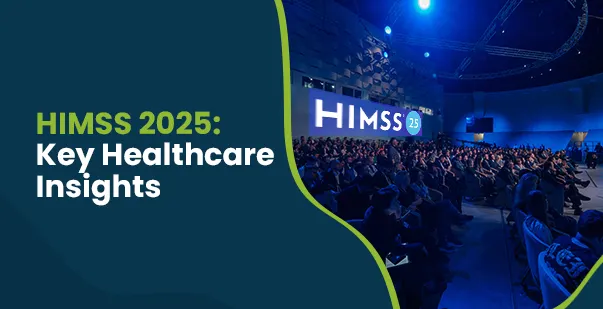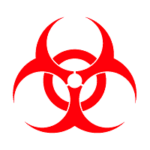Missed the Healthcare Information and Management Systems Society (HIMSS) conference in 2025?
Don’t worry, we’ve got everything you need to get up to speed. The future of healthcare isn’t waiting, and neither should you. The HIMSS Global Health Conference, held in Las Vegas, brought together over 28,000 healthcare leaders, innovators, and decision-makers. It provided a clear view of where healthcare stands today and where it is heading next.
HIMSS 2025 wasn’t about what’s coming someday. It was about what’s happening right now. Whether you’re a frontline clinician or someone shaping big-picture strategy, the lessons from this year’s conference can help you stay ahead.
Let’s explore the key takeaways, trends, and tools that are already changing healthcare today.
HIMSS25: A Confluence of Innovation and Collaboration
The HIMSS25 Global Health Conference & Exhibition, held from March 3 to 6, 2025, in Las Vegas, convened over 28,000 healthcare professionals from 88 countries, establishing itself as a pivotal event for healthcare innovation and collaboration.
Overview and Objectives
HIMSS25 brought healthcare and technology together on one platform. The event focused on key goals that drive progress in the industry:
- Advance Digital Health Transformation
The focus was on improving Electronic Medical Records (EMRs) and using next-generation systems to boost patient care. This was highlighted throughout the HIMSS Global Health Conference & Exhibition. One highlight was Epic’s launch of its AI-powered agentic platform. This platform uses conversational AI to help patients get ready for appointments and to summarize key details for clinicians.
- Epic also introduced a healthcare-specific enterprise resource planning (ERP) system. This system covers areas like workforce management, finance, and materials. Some parts of it, such as staff scheduling, are already being used.
- Promote Interoperability
The event tackled the challenges of sharing data smoothly across different healthcare systems. Better data exchange helps improve care coordination.
- Strengthen Cybersecurity
With cyber threats on the rise, the conference shared strategies to protect healthcare systems and keep patient data safe.
- Encourage Innovation
HIMSS25 gave startups and established companies a space to present new ideas. This included solutions in AI, machine learning, and digital health, with standout innovations from companies like Doctronic and Nourish leading the charge.
Global Impact
HIMSS25 brought together people from around the world to share ideas and solutions.
- Global Collaboration in Action: Global teamwork took center stage at HIMSS25. Partnerships like the Global Digital Health Partnership (GDHP) brought together 41 countries, including the U.S., UK, and Australia. Projects like Latvia’s digital heart registry with Novartis also showed how countries and companies are working together. These efforts help drive innovation and align health policies across borders.
- Policy Influence: Leaders engaged with policymakers to make sure new technologies align with regulations. This helps protect patient safety and keeps data secure.
- Equity and Access: The event also focused on making healthcare more accessible. Many shared initiatives aimed at ensuring people everywhere can get the care they need.
Why HIMSS25 Matters for Healthcare Professionals
HIMSS25 brings a lot to the table for healthcare professionals like you.
- Educational Opportunities: According to MedInsight, the event featured over 600 sessions. These covered the latest healthcare technologies and practices, helping you stay updated. Many sessions are available on-demand through the HIMSS Learning Center for members.
- Networking Platforms: Events like the Emerge Innovation Experience gave you the chance to connect with innovators, investors, and executives. These connections can open doors for future collaborations.
- Professional Growth: You also get access to continuing education credits and insights into new trends. This helps you grow your skills and advance your career. Think CHES®/MCHES® (NCHEC), CPHQ (NAHQ), CPPS (IHI), or credits through ACCME, ANCC, ACPE, CDC, IHI Open School, and HIMSS events.
Key Takeaways from HIMSS25 for Healthcare Professionals
The HIMSS25 Global Health Conference & Exhibition highlighted major shifts in healthcare technology. The focus was on AI, interoperability, digital health tools, cybersecurity, and health equity. Here’s what you need to know:
Artificial Intelligence: From Buzzword to Real-World Use
AI is no longer just a hot topic. It’s now a practical tool that supports healthcare work every day. AI-powered clinical decision systems help providers make faster, better-informed choices.
Companies like Microsoft, Zoom, and Teladoc introduced new AI tools at the conference. These tools aim to automate tasks and make healthcare workflows more efficient. One standout area was generative AI, which experts discussed for its role in improving patient communication and making clinical documentation easier. Generative AI is a type of artificial intelligence that creates new content—like text, images, or music—by learning patterns from existing data.
Interoperability: Making Healthcare Systems Work Together
Interoperability stood out as a key focus at the event. Think of a TexasThink a Texas hospital using FHIR APIs to instantly share lab results across networks—fast, seamless, life-saving. It plays a big role in helping different healthcare systems share data smoothly. The growing use of HL7 FHIR standards shows how committed the industry is to making data sharing easier.
Sessions like “Interoperability: Fueling Digital Health Innovation with Data” shared strategies to handle fragmented health data. These discussions focused on using data more effectively to improve patient care and help teams coordinate better.
Digital Health Innovations: Moving Care Beyond Hospitals
Digital health is no longer limited to hospitals and clinics. It’s now helping patients get care in new and more flexible ways. Hybrid care models, where virtual and in-person visits work together, are becoming more common. These models make care more convenient and help patients stay engaged.
The global remote patient monitoring (RPM) market is projected to grow at a compound annual growth rate of approximately 20% from 2023 to 2028, reaching around $42 billion by 2028. This growth underscores the increasing adoption of technologies like continuous glucose monitors (CGMs), which enable patients to track their blood sugar levels in real-time, facilitating timely interventions and reducing the need for frequent clinic visits.
Cybersecurity: Protecting Digital Healthcare
With healthcare becoming more digital, the need to protect data has grown. Many organizations are now using Zero Trust Architecture to stop unauthorized access. This helps keep patient information safe.
Medical devices also came up in discussions. Experts pointed out that these devices can be targets for cyberattacks. They pushed for stronger protection policies to keep devices secure in clinical settings. Medical devices have been hacked before, like when ransomware hit Change Healthcare in 2024, disrupting payments nationwide, or when hackers accessed patient data via Philips Respironics. These attacks show why stronger cybersecurity policies are urgent.
Health Equity and Digital Access
The conference also talked about how to make digital health fair for everyone. Speakers stressed the need for tools that respect different cultures and meet the needs of all communities.
There was also a big focus on digital access. Some programs are working to improve digital skills and bring healthcare tech to underserved areas. These efforts help close the gap for people who might otherwise be left out. For example, the DOORS Program. It is a community-driven initiative that offers training in key digital skills, such as using smartphones and laptops, to improve access to healthcare information and services
Highlights from the Event
Several standout speakers took the stage. Simone Biles shared her experience with mental health, and General Paul M. Nakasone spoke about cybersecurity in today’s healthcare world.
New product launches added energy to the event. Altera Digital Health introduced an AI tool that listens in the background to help with clinical documentation. The tool aims to reduce the administrative burden on healthcare providers by automatically capturing and organizing patient information during consultations.
CenTrak showed off a real-time location system (RTLS) that helps hospitals run more smoothly. This system improves operational efficiency by tracking equipment, staff, and patients in real time to reduce delays and enhance care delivery.
How to Apply HIMSS25 Innovations in Your Practice
Taking ideas from the HIMSS25 Conference isn’t just about keeping up with trends. It’s about improving patient care and preparing your practice for the future. Here’s how you can bring these innovations into your daily work:
1. Build a Digital Health Plan
To make digital changes work, you need a clear plan. Start by using HIMSS’s Maturity Models. These models help you check where you stand in areas like EMR adoption, infrastructure, and analytics. They show you what needs improvement and help you plan long term. Next, complete a Digital Health Indicator (DHI) Assessment. This helps you find gaps in your current system and set specific goals to close them.
One notable example of a hospital utilizing the HIMSS Maturity Models is Martin Luther King Jr. Community Hospital (MLKCH) in Los Angeles, California. This 131-bed acute care facility achieved Stage 7 on the HIMSS Analytics Electronic Medical Record Adoption Model (EMRAM), the highest level of IT adoption, placing it among a select group of hospitals nationwide
2. Improve Data Skills and Management
Digital tools work best when you know how to handle the data they create. Use the DIKW (Data-Information-Knowledge-Wisdom) framework. The DIKW framework illustrates the transformation of raw data into actionable wisdom. In healthcare, this progression is vital for effective decision-making. For example a patient’s electronic health record logs a blood pressure reading of 150/95 mmHg (Data). When this reading is contextualized as elevated compared to normal ranges, it becomes Information. Recognizing that such readings over time indicate hypertension constitutes Knowledge. Applying this knowledge, a clinician devises a personalized treatment plan to manage the patient’s blood pressure, demonstrating Wisdom.
This helps your team turn raw data into useful knowledge, making decisions smarter and more evidence-based. Also, set up strong data governance rules. These should focus on privacy, accuracy, and ethical use, especially as AI tools become more common in healthcare.
3. Train Clinical Staff on Technology
Training clinical staff on technology is essential to ensure effective utilization of digital tools in healthcare. However, user resistance, often stemming from unfamiliarity or perceived complexity, can hinder adoption. To address this, structured programs like Nursing Informatics Residencies can equip clinicians with the necessary tech skills, fostering confidence and competence. Additionally, promoting collaboration between clinical and IT teams ensures that digital tools are user-friendly and aligned with clinical workflows.
Innovative training methods can further mitigate resistance. Gamification introduces game-like elements into training, enhancing engagement and motivation among staff. Also, peer mentorship programs allow experienced users to guide their colleagues, providing personalized support and fostering a culture of continuous learning. These approaches not only ease the transition to new technologies but also promote a more cohesive and tech-savvy healthcare environment.
4. Expand Telehealth and Remote Monitoring
Telehealth and remote monitoring are now key parts of healthcare. They’re not extras anymore.
Add easy-to-use telehealth platforms to make care more convenient. This helps patients stick to follow-ups and lowers barriers to care. Pair telehealth with remote patient monitoring to better track chronic conditions at home. This can reduce hospital visits and make care more personal.
5. Promote Health Equity
For digital health to work well, it must be fair and inclusive. Make sure you close the digital divide by offering training, resources, and access to underserved communities.
Helping these groups engage with digital health tools ensures that progress benefits everyone, not just a few.
Challenges and Solutions in Adopting Innovations
Bringing new technology into healthcare isn’t always easy. Many organizations run into major roadblocks. Here are some of the challenges for accepting changes.
Resistance to Change
Bringing new technology into healthcare isn’t always easy. Many organizations run into major roadblocks. One of the biggest challenges is resistance to change. It’s common for healthcare workers to feel unsure about new tools that might disrupt their usual routines.
Solution: Get everyone involved early. Offer hands-on training and show how the new system actually helps improve patient care. When people understand the value, they’re more likely to support the change.
Interoperability Issues
Interoperability is also a key issue. If systems can’t share data easily, even the best technology won’t perform well.
Solution: Use standardized data formats and take part in health information exchanges. This helps different systems work together and improves communication across providers.
Workforce Burnout
Finally, there’s the human element: workforce burnout. A 2023 HIMSS study highlighted that 60% of clinicians reported feeling overwhelmed by administrative tasks.
Solution: Automating routine workflows using AI and digital tools allows clinicians to refocus on patient care, reducing emotional fatigue.
Charting the Path Forward in Healthcare Innovation
The HIMSS25 Global Health Conference underscored a pivotal shift in healthcare, highlighting artificial intelligence, digital transformation, cybersecurity, and new care delivery models as key drivers of innovation. AI-led solutions, integrated EMRs, and global collaborations are shaping a more efficient, patient-centric future, while experts emphasize the critical role of cybersecurity in protecting digital health infrastructure. These developments reflect a growing commitment to smarter, data-driven healthcare systems that are both resilient and adaptable.
Healthcare professionals are strongly encouraged to embrace these technological advancements and engage in cross-sector collaborations proactively. By adopting emerging tools like AI, healthcare providers can improve patient outcomes and enhance overall care. Together, these innovations contribute to transforming healthcare delivery and shaping a more connected, equitable global health ecosystem.






